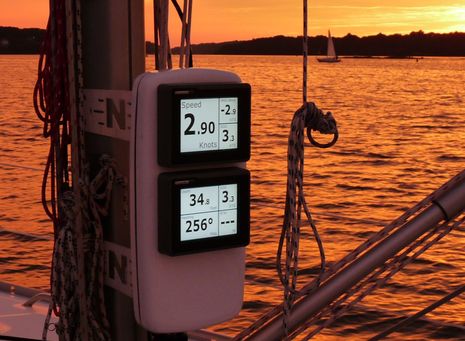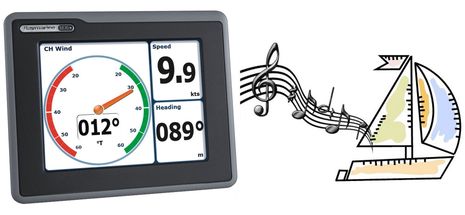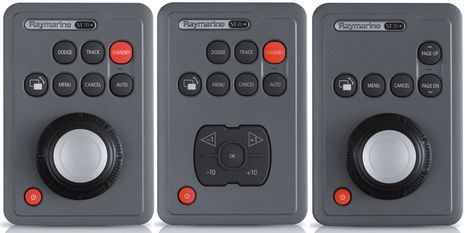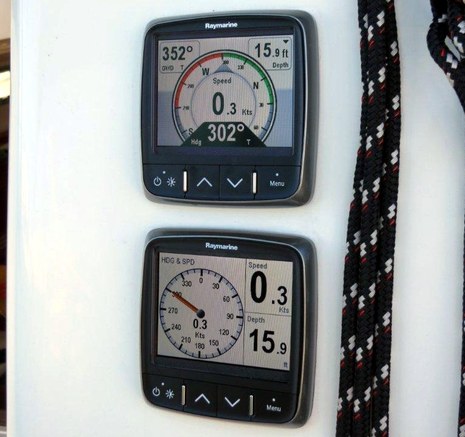Raymarine ST70 Plus, like music to my ears
A review by Dan Corcoran: The Raymarine ST60 Graphic, ST70, and the Garmin GMI10 began a transformation away from specialized instrument displays for wind, depth, speed, compass, and autopilots in large part due to the availability of sensor information from data buses like Seatalk and NMEA-2000. Although the days of single purpose instrument displays with direct connect sensors and dedicated digits or analog needles has not yet come to an end, mostly due to cost and power advantages such displays have in an environment where sunlight readable displays is a must, the time is near…
The Raymarine ST70 Plus pictured above is similar to the ST70 but with a larger screen, wired remote control (picture below), and with a capability for multiple displays to be linked together to work in concert so that features such as brightness and display modes affect all displays together with few clicks of the remote.
The pair of handsome displays pictured above spent the 2010 season as guests on Breeze Pleeze mounted in an Ocean Equipment mast mount NavPod. During the season the displays were tested on the water in lots of different weather and sailing conditions as Breeze Pleeze beer can raced on Wednesday nights, navigation raced or cruised weekends, crossed the Gulf of Maine, and generally had lots of opportunities to set up these displays in many different configurations. The displays handled all weather and light conditions with excellence, as they did the wide range of weather conditions they were exposed to out on the mast.
Much like the ST70, using a configurable general purpose display like this is not unlike switching from using a cassette player to an Apple iPod. In both cases you generally comprehend the difference in the technology improvement to be incremental, but then find yourself surprised that the product is revolutionary. I mean, cassette vs. the iPod, they both play music, just different storage mediums right? However, it is the utility the iPod and iTunes brings to managing and enjoying your music that is evolutionary and astounding. I could say the same of the VCR vs. a TiVo, TV stored on a hard disk a big deal? Yes.
Well the ST70 and ST70+ vs. dedicated displays is similar evolutionary.
The title of this piece — “Like Music to my Ears” — describe my experience with the ST70 and ST70+. These displays are configurable to show my boat performance data to me the way I want to see it. A little treble, a lot of bass, done! With my hands on the genoa and main sheet, the displays easily visible with a glance at the NavPod, I can watch my performance while keeping my head out of the cockpit. As I adjust each sheet, I am rewarded with a melody that makes me feel like I am in tune with my craft and master of the wind on my face.
And, much like an iPod allows you to customize your listening experience with playlists and other features, the ST70+ lets you customize how you consume your boat data with something like a playlist. Like grouping songs together for a purpose (exercise, relaxation, etc.), you can group boat performance data based on how you want to consume it (racing, cruising, fishing, etc.).
With Breeze Pleeze I had set up my ST70+ screens for start-of-race, windward/leeward racing, navigation-style distance racing, cruising upwind, cruising downwind, and cruising with wife at helm. With input from the crew, I’d frequently change the set up for different race strategies. The conversation usually goes like “Hey Dan, I expect a strong cross current, can we display the compass in the bottom corner next to the COG for today’s race?”. While each display is capable of displaying 6 values, at a distance of 15 feet I found three or four values to be optimum if we lose the fancy graphics and display digits only. Most boats on the race course with mast displays can only display one value per display, such that a mast with three displays would display three performance measurements, while our two ST70+ displays were configured for six or seven measurements total.
Unlike the ST70, the ST70+ displays are very bright. At night I generally turn the brightness down to 30 or 40%, which becomes a challenge the following day to brighten (at 40% the display is blank in daylight). Breeze Pleeze has a ST70 (no plus) in her cockpit installed three years ago. While I will turn up its brightness to 100% often, I found it unnecessary to ever put the ST70 Plus brightness over 80%, probably owing to a separate 12v power feed on the ST70+ rather than powering from NMEA-2000.
The power consumption of a bright color display is considerable compared to a conventional display, but for the enjoyment I receive from this product, I think a better comparison should be my stereo system (sing to me baby, sing) and for that they are about equal, and in fact I use the stereo much less now. These displays are truly like music to my ears, providing me constant feedback on the performance of my craft and my sailing skills. The power consumption for ST70+ at 80% brightness, my typical setting, is 0.65 Amps, even the two displays together are much less than my stereo playing Jimmy Buffet from the CD. In the evenings at 40% brightness the consumption is just 0.45 Amps. (Other brightness’s; 100% = 0.95 Amps, 90%= 0.75 Amps)
The NavPod in the picture above is a great match for these displays. The mount was exceptionally easy to adjust to the mast during installation, and is designed to leaves space for the Cunningham (sail adjustment) to go behind the enclosure to the deck, and the enclosure includes security features to protect the displays from walking off the boat without a special tool.
Being in love with the display it pains me to say anything negative. I could complain that it’s not an option to show rudder position or that the brightness is hard to adjust the morning after a nighttime cruise (auto-dimming would be useful, or maybe an automatic brightness bump above 50% on power-up?). I could complain about the price, with an MSRP of $ 1,465, but we all know how love can hurt.
I just can’t say enough good things about these displays. As they are evaluation units and need to be returned, I find they are exceptionally difficult to remove from the mast (an emotional thing). I was at the boat yard twice this season with tools in hand to remove them, yet they are still there.
Perhaps you can all help me out in the comments below? Maybe there is some additionally needed test to perform before I give them up, or another display you all would like me to evaluate next, that could ease the sense of loss? Go ahead and comment below.
— Dan Corcoran is an avid sailor and leads ServiceSPAN a back office work center automation technology company.


















Thanks, Dan! It would be interesting to know what sensors and other devices were on your NMEA 2000 backbone and how well they worked with the ST70 Plus displays. I think we should also note that these displays, like the original ST70, are not NMEA 2000 certified, a tricky subject I plan to get into deeper later this week.
Love, yes it sounds like it – but love with no wires….err strings — that would be a dream.
Since I can picture placing displays forward in places other than the mast… so I can watch my performance while keeping my head out of the cockpit without the real love of my life – my real captain i.e. my crew…my wife… positioned directly in line of site.
When you consider the installation costs of all that wiring – n2k standard would have you put one cable for each mast display – think of a single wireless repeater with multiple freestanding displays – positioned port and starboard based on the crew placement for different maneuvers. Of course there also downsides to having no wires…err strings.
And don’t get me wrong – I like strings – have had a strategically reinforced one attached for the past 28 years.
And Dan, my thinking let alone my circuits always seem a few steps behind yours.
But some serious questions.
Multiple Sensors: In some setups there are multiple sensors putting out the same information (say a PB200 with GPS output at masthead and another GPS at deck – or say a Simrad AP28 pilot which ‘creates’ reflective strings out of nothing for some reason)- not all displays are easily selective of the data they display – are these?
Ipad ?bluetooth? repeater? – comparison of display visibility in the height of the August sun – you would have to keep the sT70Plus until then to do this!!
Thanks.
Good writeup Dan,
I really like the direction that Raymarine is taking this and think they should take it one step father. Why does there need to be so much differentiation between a “Plotter” and an “Instrument”? They are just displays, and should be able to display whatever you want like a chart, radar, or camera off of a networked plotter. I would love to get rid of a couple of my current four instruments at the helm and install one ST70 Plus that could also repeat the chart or radar display off of the plotter mounted under the dodger 7 feet away. I wouldn’t go the full client server route like Nexus, but NMEA data could be independent while other data is passed over ethernet.
I agree with you on the price, but when you look at having to buy fewer instruments and not having to buy the autopilot display, I think it starts to make some sense. One gripe i have is that the autopilot for sailboats has those damn buttons instead of the rotary knob like on the power boat model. This is personal preference of course, but I have come to love the rotary knob on my old Robertson. All in all, I like it and would like to see more of this from other manufacturers.
Kenyon
Kenyon, interestingly there is a color all-in-one instrument display that’s sort of like an ST70, but with Ethernet as well as NMEA 2000 (and 0183). It’s the Geonav MID 110,and though Geonav hasn’t really specified what the Ethernet is for, I believe they are thinking along the same lines you are: http://goo.gl/FlWk3
What a fantastic display device. It would be good to see Raymarine (and others) truly get behind NMEA-2000 and have some user configurable pages for display of non navigation data as well.
The only choice I had recently for the above data was a Garmin GMI-10. It would be good if future testing of this type of instrument made a point of covering the extent of NMEA-2000 pgn support.
Dan
I don’t have the ST70+. Instead, I have 4 Furuno FI-504s up on the mast and 3 Simrad IS-20s graphics and an AP24 on the bulkhead. This is a racing setup and I really prefer it to B&G 20/20s. The FI-504s are very nice, day and night. I haven’t integrated the IS20s yet but the AP24 is a display when it isn’t an AP head, a nice feature.
I’m very curious about your playlist approach. Is it manual? Do you just have to change one display? What I’d really like is the ability to set the displays remotely from a laptop. I just rounded the windward mark. I’d like to change my displays for offwind. This requires some N2K protocol support because otherwise it’s manual and distracting.
One BIG COMPLAINT I have with all of these displays is that I can’t display everything I want in whatever format I want. Case in point, the FI504 has a wonderful feature: pitch/roll. It can actually display pitch/roll information from the Airmar H2183. Upwind, roll is kinda nice to see on the mast. Downwind pitch is more important than you’d think. Nice feature. But while the Airmar will has subdegree accuracy, you can’t display it on the FI504. So instead it flips between 1 and 2.
Furuno, if you’re listening. Great feature but N2K PGN 127257 has a resolution of 0.001 and the Airmar H2183 supports subdegree accuracy. Let us display tenths of a degree if we want to. One degree may seem like a lot but for pitch it isn’t.
I had FI503s for the bulkhead but had to replace them with the Simrad IS20s. With the 503s, there are three display lines but you can only put certain things on certain lines. Again, let the customer decide what they want to display and where. I got rid of the 503s because although I had 6 display lines I could really only display 3 interesting pieces of information. Temperature is not interesting.
Ben,
I think that Maretron has been doing this for some time with the DSM250. If you would like I can send you an update for N2K Builder
Bob
Gary, The ST70 and 70+ will definitely display some engine and system PGNS, screens here: http://goo.gl/luZDX
Unfortunately, though, I don’t think Raymarine publishes lists of PGNs supported by any of its gear yet, and generally you can’t pick or name sources for multiple instances of the same PGN, like temperature (I saw how you’re using the GMI10 to monitor refrigeration).
Bob, if you mean showing NMEA 2000 data in color, the Maretron DSM250 certainly does, and it may understand more PGNs and N2K subtleties than any other all-in-one instrument display. But it doesn’t have Ethernet input like the Geonav MID 110 I commented about.
I can also verify that the DSM250 does the best job of all in having the broad pgn coverage of any NMEA-2000 instrument. If only Maretron could modernise the device with a better looking display and bezel.
The Geonav MID 110 looks interesting but their detail specifications do not mention coverage for levels (other than fuel), temperature (other than ambient and sea water) and battery status. Looks like a good marketing opportunity for the Geonav.
Sure Ben, the sensors on Breeze Pleeze include the following:
NMEA2000 :
Airmar PB200 weather station, Airmar H2183 solid state compass, Maretron DCM-100 Direct Current Monitor, Maretron TLM-100 Tank Level Monitor x 3
NMEA 2000 (with Raymarine E-80 as a bridge to seatalk):
Raystar 125 GPS
Raymarine Speed, Depth
E-80 Navigation Bearing to Waypoint
Tested with ST70 & ST70+
Depth, Speed, AWA, AWS, TWA, TWS, VMG Wind
Heading, SOG, COG
BTW, Log, Time
Barometric Pressure, Sea Temp, & Air Temp
The wiring is as follows:
– Maretron mid sized cable backbone, Maretron field installable connector on Raymarine NMEA-2000 NG spur cable, two displays are then daisy chained with Raymarine NMEA-2000 NG spur cable
– 12 gauge power cable (28 feet)
Chris, playlist of course is my word for the capability (as compared to iPod), I believe Raymarine calls them configurations of which you can have 8. For example I have windward/leward racing as configuration 1, downwind as configuration 2, wife at helm as 3, etc.
I then setup the two displays to be in a single group. So whenever I choose configuration 1, 2, etc. the two displays together switch to the windward/leward configuration, etc. Same goes with brightness and other options, the two displays change together in concert.
An interesting project on-going by British Artist and ocean sailor Lia Ditton, that actually takes boat performance data and turns it into listening music (from her web page http://www.liaditton.com/
• (Ongoing) The Open Boat Orchestra (OBO) Project is a unique venture, which transforms any boat with marine electronic instruments into a live digital orchestra. The commercial product derived from the ‘Open Boat Orchestra’ Project, the OBO Box, is a bespoke synthesizer that is driven by the boat’s telemetry to create a new form of experimental music. The brainchild of Lia Ditton, the OBO Box has been developed with musicians – ex-Duran Duran sound engineer, Mark Ty-Wharton consulting with TED Talks music director Thomas Dolby. The Open Boat Orchestra is about celebrating our experience of the sea, through the universal language of music.
Dan
if you are setting a group mode on one ST70 and the others are changing in lockstep then the one is configuring the others over N2K. Maybe the PGNs aren’t public yet but they’d be easily traced with an Actisense.
Dan,
Where are the Maretron DCM-100 Direct Current Monitor, Maretron TLM-100 Tank Level Monitor x 3 displayed? Had you tried these on the ST70?
Outbackgary, I did experiment with the ST70 and the DCM-100. A future entry will discuss the DCM-100 side by side with the now discontinued link 20 as a potential replacement. There are important pieces of DCM-100 information that are not available on the ST70 preventing an ST70 & DCM-100 combination from being a replacement for the link 20.
Configurable data displays/repeaters have been around awhile, and one drawback we noted with our customers was how much time was spent with head down trying to reconfigure or reset a display.
Our solution generally had been to dedicate one display for showing depth, connected only to the most reliable depth source or directly to a smart transducer….this way you can rely on that one instrument for depth rather than searching on MFD or multi-data displays to find it.
Many skippers don’t spend enough time making their electronics operation familiar enough, so we tried to find ways to make critical info and operations less confusing.
I am looking to replace my two ST70+ instruments. Anything available ?
Everyone makes great displays now, and they are interchangeable. Of the displays that fit the same form factor, I have only personally used the B&G Triton 2’s and Garmin’s (not sure which one it was) recently. The B&G has a slight edge in the areas of variables that can be displayed, the Garmin has a significant edge over B&G in brightness, number of pixels, and how beautiful the graphics are. The Garmin is rumored to be better for displaying Expedition Information but I don’t know if that applies to the product in the form factor of your Raymarine. And not last, I just don’t have one, the Raymarine i70 looks really good and should be something you consider first.